#sustainable irrigation projects
Explore tagged Tumblr posts
Text
Coastal Landscape Construction

Website: https://www.coastallandscapes.net.au
Address: Melbourne, Victoria, Australia
Coastal Landscape Construction, a boutique landscaping service based in Melbourne, specializes in bringing clients' landscaping visions to life. With 16 years of industry experience, they offer comprehensive services including garden makeovers, new entertaining areas, construction, irrigation, drainage, decking, screens, garden lighting, and paving. As registered builders, they ensure quality and reliability in every project.
Facebook: https://www.facebook.com/coastallandscapeconstruction
Instagram: https://www.instagram.com/coastallandscapeconstruction/
Keywords:
residential landscaping near me
commercial landscaping near me
residential landscaping services
landscape construction near me
professional garden services
landscape project management
water feature installations
drainage systems installation
sustainable irrigation systems
sustainable landscaping solutions
contemporary landscape architecture
landscape construction services
landscape design solutions
urban oasis landscaping
sustainable landscaping near me
commercial landscaping melbourne
drainage systems near me
custom landscaping near me
landscape renovation near me
modern landscape designs
residential landscaping melbourne
outdoor entertaining areas design
water wise garden design
bespoke garden features
tree and shrub planting services
sustainable landscaping melbourne
melbourne landscaping experts
irrigation solutions for gardens
quality decking for outdoor spaces
garden screens installation
durable paving solutions
commercial landscaping projects
landscape renovation experts
custom landscaping designs
garden transformation services
expert garden planners
creative outdoor spaces design
customized garden solutions
hardscape and softscape design
eco friendly landscaping options
personalized garden makeovers
outdoor living space enhancements
indigenous plant landscaping
themed landscape installations
green roof and wall solutions
native flora landscaping
eco conscious landscape planning
vibrant flowerbed arrangements
natural stone paving options
outdoor kitchen and bbq areas
all season garden designs
garden sculptures and art
garden furniture selection
fire pit and outdoor heating solutions
seasonal garden maintenance
portsea garden makeover
melbourne outdoor entertaining areas
landscape design in portsea
irrigation solutions melbourne
drainage systems portsea
quality decking melbourne
garden screens portsea
atmospheric garden lighting in melbourne
durable paving solutions portsea
commercial landscaping portsea
landscape renovation in melbourne
custom landscaping portsea
professional garden services melbourne
innovative landscape design portsea
garden transformation portsea
landscape project management melbourne
portsea garden construction
melbourne garden renovation
outdoor lighting in portsea
melbourne garden makeover
portsea garden design
melbourne irrigation specialists
portsea drainage experts
quality decking in melbourne
paving solutions in melbourne
residential landscaping portsea
garden makeover services near me
melbourne landscaping near me
outdoor entertaining areas near me
irrigation solutions near me
quality decking near me
garden screens near me
atmospheric garden lighting near me
durable paving solutions near me
professional garden services near me
innovative landscape design near me
garden transformation near me
landscape project management near me
#residential landscaping near me#commercial landscaping near me#residential landscaping services#landscape construction near me#professional garden services#landscape project management#water feature installations#drainage systems installation#sustainable irrigation systems#sustainable landscaping solutions#contemporary landscape architecture#landscape construction services#landscape design solutions#urban oasis landscaping#sustainable landscaping near me#commercial landscaping melbourne#drainage systems near me#custom landscaping near me#landscape renovation near me#modern landscape designs#residential landscaping melbourne#outdoor entertaining areas design#water wise garden design#bespoke garden features#tree and shrub planting services#sustainable landscaping melbourne#melbourne landscaping experts#irrigation solutions for gardens#quality decking for outdoor spaces#garden screens installation
2 notes
·
View notes
Text
Addressing Kenya’s Acute Maize Seed Shortage: Strategic Interventions for Sustainable Seed Production and Food Security
“Explore strategic solutions to Kenya’s acute maize seed shortage. Learn how climate-smart agriculture, local seed production, and irrigation technologies can ensure sustainable food security.” “Kenya’s maize seed crisis impacts farmers and food security. Discover key interventions to boost seed production, lower costs, and reduce dependence on imports.” “Addressing Kenya’s maize seed shortage:…
#climate change impact on maize farming#fall armyworms Kenya#Galana Kulalu maize project#government interventions maize farming#irrigation for maize production#Kenya food security strategies#Kenya maize seed shortage#KEPHIS seed inspection Kenya#local maize seed growers#maize farming challenges Kenya#maize farming climate-smart solutions#maize farming inputs cost#maize lethal necrotic disease#maize seed demand Kenya#maize seed genetic purity.#maize seed imports Kenya#maize seed prices 2024#maize seed production in Kenya#pest control in maize farming#sustainable food security Kenya
0 notes
Text
District Reviews PM-Kusum Yojana Progress in Jamshedpur
Solar Pump Initiative Aims to Boost Agricultural Productivity DM Ananya Mittal urges swift processing of applications to benefit eligible farmers. JAMSHEDPUR – District Magistrate cum Deputy Commissioner Ananya Mittal conducted a review meeting for the PM-Kusum Yojana at the Collectorate Auditorium, focusing on application progress and scheme implementation. "This initiative has the potential to…

View On WordPress
#Ananya Mittal DM#जनजीवन#farmer support programs#irrigation improvement projects#Jamshedpur agriculture initiatives#Jamshedpur rural development#Life#PM-Kusum Yojana Jamshedpur#rural electrification schemes#solar energy in farming#solar pump subsidies#sustainable agriculture Jharkhand
0 notes
Text
Coastal Landscape Construction

Website: https://www.coastallandscapes.net.au
Address: Melbourne, Victoria, Australia
Coastal Landscape Construction, a boutique landscaping service based in Melbourne, specializes in bringing clients' landscaping visions to life. With 16 years of industry experience, they offer comprehensive services including garden makeovers, new entertaining areas, construction, irrigation, drainage, decking, screens, garden lighting, and paving. As registered builders, they ensure quality and reliability in every project.
Facebook: https://www.facebook.com/coastallandscapeconstruction
Instagram: https://www.instagram.com/coastallandscapeconstruction/
Keywords:
residential landscaping near me
commercial landscaping near me
residential landscaping services
landscape construction near me
professional garden services
landscape project management
water feature installations
drainage systems installation
sustainable irrigation systems
sustainable landscaping solutions
contemporary landscape architecture
landscape construction services
landscape design solutions
urban oasis landscaping
sustainable landscaping near me
commercial landscaping melbourne
drainage systems near me
custom landscaping near me
landscape renovation near me
modern landscape designs
residential landscaping melbourne
outdoor entertaining areas design
water wise garden design
bespoke garden features
tree and shrub planting services
sustainable landscaping melbourne
melbourne landscaping experts
irrigation solutions for gardens
quality decking for outdoor spaces
garden screens installation
durable paving solutions
commercial landscaping projects
landscape renovation experts
custom landscaping designs
garden transformation services
expert garden planners
creative outdoor spaces design
customized garden solutions
hardscape and softscape design
eco friendly landscaping options
personalized garden makeovers
outdoor living space enhancements
indigenous plant landscaping
themed landscape installations
green roof and wall solutions
native flora landscaping
eco conscious landscape planning
vibrant flowerbed arrangements
natural stone paving options
outdoor kitchen and bbq areas
all season garden designs
garden sculptures and art
garden furniture selection
fire pit and outdoor heating solutions
seasonal garden maintenance
portsea garden makeover
melbourne outdoor entertaining areas
landscape design in portsea
irrigation solutions melbourne
drainage systems portsea
quality decking melbourne
garden screens portsea
atmospheric garden lighting in melbourne
durable paving solutions portsea
commercial landscaping portsea
landscape renovation in melbourne
custom landscaping portsea
professional garden services melbourne
innovative landscape design portsea
garden transformation portsea
landscape project management melbourne
portsea garden construction
melbourne garden renovation
outdoor lighting in portsea
melbourne garden makeover
portsea garden design
melbourne irrigation specialists
portsea drainage experts
quality decking in melbourne
paving solutions in melbourne
residential landscaping portsea
garden makeover services near me
melbourne landscaping near me
outdoor entertaining areas near me
irrigation solutions near me
quality decking near me
garden screens near me
atmospheric garden lighting near me
durable paving solutions near me
professional garden services near me
innovative landscape design near me
garden transformation near me
landscape project management near me
#residential landscaping near me#commercial landscaping near me#residential landscaping services#landscape construction near me#professional garden services#landscape project management#water feature installations#drainage systems installation#sustainable irrigation systems#sustainable landscaping solutions#contemporary landscape architecture#landscape construction services#landscape design solutions#urban oasis landscaping#sustainable landscaping near me#commercial landscaping melbourne#drainage systems near me#custom landscaping near me#landscape renovation near me#modern landscape designs#residential landscaping melbourne#outdoor entertaining areas design#water wise garden design#bespoke garden features#tree and shrub planting services#sustainable landscaping melbourne#melbourne landscaping experts#irrigation solutions for gardens#quality decking for outdoor spaces#garden screens installation
1 note
·
View note
Text
"In an unprecedented transformation of China’s arid landscapes, large-scale solar installations are turning barren deserts into unexpected havens of biodiversity, according to groundbreaking research from the Chinese Academy of Sciences. The study reveals that solar farms are not only generating clean energy but also catalyzing remarkable ecological restoration in some of the country’s most inhospitable regions.
The research, examining 40 photovoltaic (PV) plants across northern China’s deserts, found that vegetation cover increased by up to 74% in areas with solar installations, even in locations using only natural restoration measures. This unexpected environmental dividend comes as China cements its position as the global leader in solar energy, having added 106 gigawatts of new installations in 2022 alone.
“Artificial ecological measures in the PV plants can reduce environmental damage and promote the condition of fragile desert ecosystems,” says Dr. Benli Liu, lead researcher from the Chinese Academy of Sciences. “This yields both ecological and economic benefits.”
The economic implications are substantial. “We’re witnessing a paradigm shift in how we view desert solar installations,” says Professor Zhang Wei, environmental economist at Beijing Normal University. “Our cost-benefit analysis shows that while initial ecological construction costs average $1.5 million per square kilometer, the long-term environmental benefits outweigh these investments by a factor of six within just a decade.” ...
“Soil organic carbon content increased by 37.2% in areas under solar panels, and nitrogen levels rose by 24.8%,” reports Dr. Sarah Chen, soil scientist involved in the project. “These improvements are crucial indicators of ecosystem health and sustainability.”
...Climate data from the study sites reveals significant microclimate modifications:
Average wind speeds reduced by 41.3% under panel arrays
Soil moisture retention increased by 32.7%
Ground surface temperature fluctuations decreased by 85%
Dust storm frequency reduced by 52% in solar farm areas...
The scale of China’s desert solar initiative is staggering. As of 2023, the country has installed over 350 gigawatts of solar capacity, with 30% located in desert regions. These installations cover approximately 6,000 square kilometers of desert terrain, an area larger than Delaware.
“The most surprising finding,” notes Dr. Wang Liu of the Desert Research Institute, “is the exponential increase in insect and bird species. We’ve documented a 312% increase in arthropod diversity and identified 27 new bird species nesting within the solar farms between 2020 and 2023.”
Dr. Yimeng Wang, the study’s lead author, emphasizes the broader implications: “This study provides evidence for evaluating the ecological benefit and planning of large-scale PV farms in deserts.”
The solar installations’ positive impact stems from several factors. The panels act as windbreaks, reducing erosion and creating microhabitats with lower evaporation rates. Perhaps most surprisingly, the routine maintenance of these facilities plays a crucial role in the ecosystem’s revival.
“The periodic cleaning of solar panels, occurring 7-8 times annually, creates consistent water drip lines beneath the panels,” explains Wang. “This inadvertent irrigation system promotes vegetation growth and the development of biological soil crusts, essential for soil stability.” ...
Recent economic analysis reveals broader benefits:
Job creation: 4.7 local jobs per megawatt of installed capacity
Tourism potential: 12 desert solar sites now offer educational tours
Agricultural integration: 23% of sites successfully pilot desert agriculture beneath panels
Carbon reduction: 1.2 million tons CO2 equivalent avoided per gigawatt annually
Dr. Maya Patel, visiting researcher from the International Renewable Energy Agency, emphasizes the global implications: “China’s desert solar model could be replicated in similar environments worldwide. The Sahara alone could theoretically host enough solar capacity to meet global electricity demand four times over while potentially greening up to 20% of the desert.”
The Chinese government has responded by implementing policies promoting “solar energy + sand control” and “solar energy + ecological restoration” initiatives. These efforts have shown promising results, with over 92% of PV plants constructed since 2017 incorporating at least one ecological construction mode.
Studies at facilities like the Qinghai Gonghe Photovoltaic Park demonstrate that areas under solar panels score significantly better in environmental assessments compared to surrounding regions, indicating positive effects on local microclimates.
As the world grapples with dual climate and biodiversity crises, China’s desert solar experiment offers a compelling model for sustainable development. The findings suggest that renewable energy infrastructure, when thoughtfully implemented, can serve as a catalyst for environmental regeneration, potentially transforming the world’s deserts from barren wastelands into productive, life-supporting ecosystems.
“This is no longer just about energy production,” concludes Dr. Liu. “We’re witnessing the birth of a new approach to ecosystem rehabilitation that could transform how we think about desert landscapes globally. The next decade will be crucial as we scale these solutions to meet both our climate and biodiversity goals.”"
-via Green Fingers, January 13, 2025
#solar#solar power#solar panel#solar energy#solar farms#china#asia#ecosystem#ecology#ecosystem restoration#renewables#biodiversity#climate change#climate action#good news#hope
912 notes
·
View notes
Text
Dandelion News - November 8-14
Like these weekly compilations? Tip me at $kaybarr1735 or check out my Dandelion Doodles!
1. Agrivoltaics for sustainable food, energy and water management in East Africa

“[… C]ertain crops […] thrived under the partial shade provided by solar panels. The shade also helped to reduce water loss through evaporation, leading to more efficient water usage. Additionally, rainwater harvested from the panels could be used to supplement irrigation needs.”
2. The world’s largest wildlife crossing is now standing in California

“The structure crosses a 10-lane freeway and has been built to help protect all sorts of wildlife[….] And it’s not just for fauna: some 5,000 plants grown from seed collected within a five-mile radius have been nurtured in two specially created nurseries. The bridge will be topped with wildflowers, shrubs and native grasses that will also benefit insect populations.”
3. Judge rules the military must cover gender-affirming surgery for members' dependents

“[Judge] Torresen found that [gender-affirming] surgery is indeed medically necessary and that the Defense Department had not shown that any important governmental interest was advanced by denying the coverage.”
4. Social Media Can Boost Caracal Conservation

“The team found that searches on the species doubled after the project [using “social media to educate about the caracal”] launched. […] ”The research demonstrates how a public interest in urban ecology and the global phenomenon of ‘cats on the internet’… can be harnessed to leverage conservation action.””
5. US Labor Board Bans Captive Audience Meetings to Ensure 'Truly Free' Worker Choice

“[T]he National Labor Relations Board on Wednesday ruled that employers cannot force workers to attend anti-union speeches. [… W]orkers will no longer have to take part in so-called "captive audience meetings," which employers often use as a union-busting tool and a form of coercion.”
6. Study links grazing with plant phenology and abundance

“In general, plants where caribou or muskoxen were present experienced earlier green-up and greater abundance later in the growing season. “We're used to thinking of the timing of plant availability as impacting the productivity of grazing animals, but not the reverse," Post said.”
7. Frog populations once decimated by disease mount a major comeback
“"These results provide a rare example of how reintroduction of resistant individuals can allow the landscape-scale recovery of disease-impacted species, and have broad implications for amphibians and many other taxa that are threatened with extinction by novel pathogens."”
8. California Announces Special Session To Protect Trans People

“Newsom’s directive is clear: safeguard reproductive healthcare, support immigrants, and shield LGBTQ+ people from what is viewed as existential threats to civil rights and democratic norms. […] California has a unique opportunity to set the blueprint for other states in resisting a Trump administration[….]”
9. When ‘OK, Boomer’ Means ‘Let’s Go Protest’

“Youth activists across the country recognize the efforts of their eco-minded predecessors and welcome them as mentors, role models, and collaborators in their battle against the climate crisis. […] “The idea that Boomers don’t care, he said, is “just misinformation.””
10. How Aussie Waste Warriors are Redirecting Excess Food to Those in Need

“A growing movement is working to reduce perfectly good food going to waste by redirecting it to homes and charities. [… C]haritable organisations [… are] transforming fresh produce that would otherwise have gone to waste into millions of cooked, nutritious meals for people in need each year.”
November 1-7 news here | (all credit for images and written material can be found at the source linked; I don’t claim credit for anything but curating.)
#hopepunk#good news#nature#solar panels#solar power#agriculture#water conservation#wildlife#native plants#military#us military#gender affirming care#trans rights#big cats#workers rights#unionize#labor rights#muskox#caribou#frogs#reintroduction#conservation#california#gavin newsom#activism#solidarity#food#food waste#food insecurity#us politics
289 notes
·
View notes
Text
Sustainable changes
Nicolas had just been promoted to Senior Product Manager. But the condition was that he had to take a foreign assignment for two years. He had reckoned with Germany, the USA or maybe Japan. India would also have been okay. But he was supposed to go to Turkmenistan. His employer had just bought a large agricultural cooperative there, which was now to be converted in the direction of ecological and sustainable agriculture. On the one hand, this sounded like a completely unknown field of work. Nicolas had previously worked more in the consumer goods sector. On the other hand, anything that bore the label "sustainable" was naturally a career driver at the moment. So he took a cautiously optimistic approach.
Once Nicolas arrived at his new workplace, the optimism quickly evaporated. He had arrived somewhere in the middle of nowhere. There was no office building, there were only barracks. Mostly not air-conditioned. He had expected to be put up in some hotel. But he had been given a room with a farmer. Toilet in the yard. Bathroom was an outdoor shower served from the cistern. He felt infinitely silly in his outfit.

In the first service meeting, a colleague asked him if they could tweak Nicolas's resume a bit for the presentation to the workers. It might be good for his credibility if they could give him some local roots. Nicolas was tired. The trip had been exhausting. He remembered his parents' Russian gardener. A picture of a man. Former combat swimmer. And of the Turkish cook. So he answered, one may mix in there with pleasure something Russian and Turkish. The main thing was that he was allowed to retire now.
The night had been hell. It smelled like a pigsty in his room. And he could hear the pigs too, as if they were sleeping in bed with him. There was no hot water to shave with. And company policy forbids the use of shower gels containing microplastics without functioning wastewater treatment for environmental reasons. So all he can use is a bar of curd soap. When introduced to the staff, he looks appropriately a bit bedraggled. One of his colleagues asks Nicolas to say something in Russian. He has to think a bit. His grandmother sometimes spoke to him in Russian. But it's enough for a "I'm happy to be here and look forward to working with you. The employees cheer for their new boss.
Before Nicolas takes a shower the next morning, he drives the pigs out of the barn. If he's going to share the roof with them, he might as well make himself useful. His hosts invite him to breakfast. The conversation in Russian is still a bit bumpy. Nikolai hasn't spoken his father's language for years. And his host family, of course, actually speaks Turkmen. But with hands and feet it works. And so it goes on in the office. The team meeting was supposed to take place in English. But the interpreter dropped out. With every hour it gets better. The memory of his father's language comes back.
At breakfast, Nikolai realizes that he understands Turkmen better than he thought. It definitely works out that his hosts ask him in their native language. But he prefers to answer in Russian. Nikolai speaks it again as fluently as he did when he lived with his father in the Sevastopol army barracks. At work, they discuss the tasks for the next few days. Nikolai considers the projects for preventing soil erosion and unused surface water runoff to be urgent. Everyone passionately discusses the possibilities of transforming agriculture to get by without artificial irrigation. But Nikolai realizes that it will be difficult to irrigate only naturally in the desert.
The next morning, Nikolai surprises your host family with a few words of Turkmen. With his fluency in Russian and Turkish as his mother's language, it's not that hard for him to learn the language. On the job, they speak almost only Turkmen anyway. Today, his job is to drive the fields and inspect and document the environmental damage. Nikolai doesn't even need to shower for that. It will be hot anyway. And air conditioning is only for wimps. The point is to save energy wherever possible. In the afternoon, he gets a call from headquarters. They are very pleased with his work on site. It is clear that the project would not make an economic contribution. But the advertising impact is enormous. Whether he is interested in accepting a junior director position at the headquarters in Paris.

Nikolai turns his camera, bares his left breast and says in broken French that his heart beats for his new home. He won't leave until the desert blooms again.
581 notes
·
View notes
Text
A solar-powered house with eco-waste management
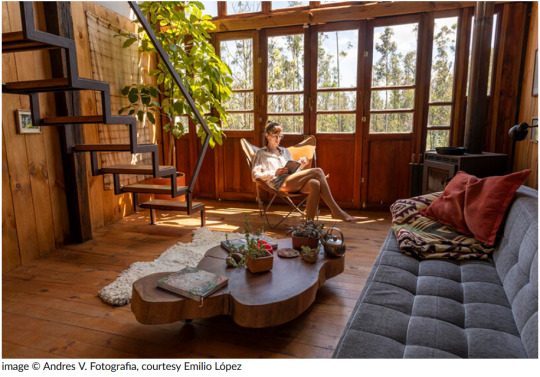
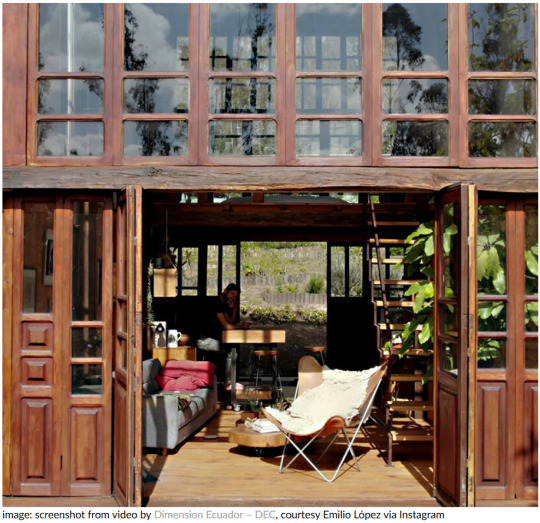
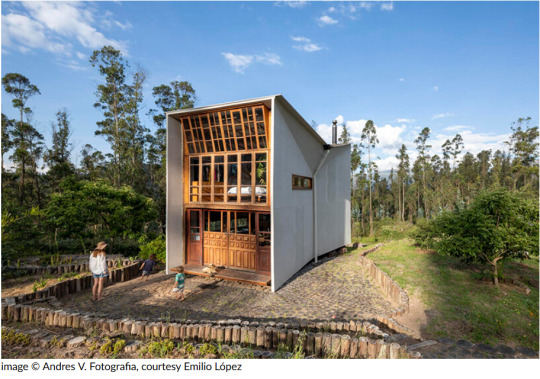
Water and energy conservation are also vital elements of Casa Quinchuyaku by Emilio López (see more here). The house collects and stores water from existing decks, while the roof facilitates water collection and houses energy storage batteries for solar panels, which provide 100% of the electrical energy needed. In response to the intense erosion process affecting the slopes of Ilaló, the project focuses on soil regeneration, using gray water from bathrooms and kitchens for tree irrigation and implementing terraces and rainwater infiltration ditches to improve soil conditions. Furthermore, Casa Quinchuyaku incorporates sustainable waste management practices, including a dry bath system that converts human waste into compost for plants and trees, as well as composters for organic kitchen waste. This project serves as a harmonious blend of architecture, landscape, and sustainability, showcasing a holistic approach to environmentally responsible living.
#solarpunk#solar punk#solarpunk aesthetic#architecture#passive solar#eco-waste management#design#house#ecuador
38 notes
·
View notes
Text
Scientific knowledge and technology played a significant role in the expansion of colonial rule in India and the consequent incorporation of the Indian sub-continent into the [commercialized, imperial] world-system [...]. The colonization of nature, territory and people in British India led to a mutually constitutive interplay [...].
By the time the East India Company managed to establish a foothold in Bengal in 1757, [...] [a]fter the acquisition of the formal rights to collect revenues in the states of Bengal, Bihar and Orissa, the issue of obtaining accurate information about the extent of the produce, the population and other social statistics assumed significance. The detailed scientific surveys [...] were possible due to the large number of amateur scientists employed by the Company. Over time, these surveys played a major role in the transformation of a trading company into a colonial state [...] and the incorporation of India into the modern world-system. [...]
---
Considered the founder of British geography, James Rennell arrived in India in 1760 barely three years after the decisive battle of Plassey. Rennell’s cartographic skills caught the attention of the governor of Bengal presidency, who was ‘anxious to inaugurate some system for correcting and revising the geography of Bengal’ [...]. Rennell’s mapping out in great detail the area under the Company was indispensable for the rationalization of the extraction of surplus, administrative strategies and techniques of control. [...] In 1777 he left for England, and two years later he published the Bengal Atlas that led to his election to the Royal Society. [...] With reference to the ‘science wars’, [...] Rennell’s work was also incorporated in the key text[s] of the time, C. Lyell’s Principles of Geology (1830) [...] [and] the work of [...] Humboldt and Carl Ritter. Rennell’s surveys contributed to the organized [...] surveys [across wider regions of India] that followed after the defeat of Tipu Sultan of Mysore in 1799. [...] [Mysore's] sustained resistance to British power had a major impact on the general consciousness in Britain. [...]
Thomas de Quincey extolled the virtues of the ‘British bulldog’ against [...] the tyrannical ‘Bengal tiger’ [...]. The scientific knowledge that emerged as a consequence of the surveys of Mysore contributed [...] to the consolidation of administrative power [...]. The key figures associated with the surveys [included] Colin Mackenzie [...]. Mackenzie’s ethnographic notes contributed to imperial perceptions of the [...] [people of South Asia] and the grid of anthropological knowledge through which administrative power was deployed. [...]
---
Nature, culture and colonial power were inextricably implicated in the production of scientific knowledge and of colonial society. [...] The establishment the Public Works Department in 1854 provided fresh impetus for the deployment of science and technology in grappling with problems precipitated by colonial rule. Declining revenues for the Company focused attention on gigantic irrigation and other public works projects. [...]
The irrigation projects were expanded to include the railways (1849), the telegraph (1852), and the postal system (1850). Together, they represented the largest state-sponsored enterprise undertaken anywhere at that time. Lord Dalhousie, under whose tenure these projects were inaugurated, declared the railways, the telegraph and the postal system as the ‘three great engines of social improvement’.
His predecessor William Bentinck had already termed the railways ‘the great engine of moral improvement’ in a country ‘cursed from one end to the other by the vice, the ignorance, [...] the barbarous and cruel customs that have been the growth of ages under every description of Asian misrule’ [...]. Later observers were to wax ever more eloquent on the role of the railways in the modernization of India. For W. A. Rogers of the Indian Civil Service, railways ‘are opening the eyes of the people … they teach them that speed attained is time, and therefore money, saved or made’ (Adas1989: 226). The importance of a network of railways, connecting the cotton plantations of the Deccan region to the ports became significant especially during the 'cotton famine' of 1846 [...].
---
Almost immediately after Dalhousie left India, secure in the belief that the double engines of moral improvement and legitimacy were at work, the rebellion of 1857 put an end to such expectations. The rebellion was partly triggered in response to the wide-ranging transformations [...] triggered off by the introduction of [these] new [colonial infrastructures] [...].
In the end, the rebellion was violently suppressed by the very technologies that had precipitated it in the first place. [...]
---
All text above by: Zaheer Baber. "Colonizing nature: scientific knowledge, colonial power and the incorporation of India into the modern world-system". British Journal of Sociology 52(1), pages 37-58. April 2001. [Bold emphasis and some paragraph breaks/contractions added by me. Presented here for commentary, teaching, criticism purposes.]
#ecology#abolition#multispecies#landscape#geography#temporal#temporality#colonial#imperial#tidalectics#indigenous#archipelagic thinking#intimacies of four continents#plantations#carceral geography#opacity and fugitivity#indigenous pedagogies#black methodologies
38 notes
·
View notes
Text
COJEHA: Help Empower Haiti's Youth - Brighter Sustainable Future
Current progress: $11,339/$100,000
"Centre d'Organisation de la Jeunesse d'Haïti (COJEHA), a Haitian family founded Non-Governmental Organization, needs your support. In 2023, our headquarters in Port-au-Prince were overrun by gangs, displacing our workers and children. With funds depleted, we're reaching out to global citizens for help. Our mission is clear: to uplift Haiti's youth through education, community support, and essential services. Founded in 2017, COJEHA focuses on sustainable development, emphasizing education and agriculture to empower children and their communities. We intervene, support and enrich by: - Establishing agricultural projects, fostering entrepreneurship among youth. - Supporting financially disadvantaged students. - Combating juvenile delinquency by ensuring nearby children attend school. - Encouraging civic responsibility and mutual aid among Haitian youth.
...
Your support will enable us to: - Continue to build our headquarters which will work as a community center in the North-East region in Haiti. - Fill our barren lake so that it acts as a fish pond as well as irrigation for the land - Develop the land for sustainable farming, which will ensure; 1. A continuous source of food for our children and the surrounding community 2. Plots for students to learn how to grow for themselves through our Agribusiness program 3. Sell crops in local markets to sustain the organization. - Invest in the necessary resources and infrastructure for agricultural production and marketing. - Cover school fees until we achieve full operational self-sustainability."
6 notes
·
View notes
Text
Baby Corn Farming: A Unique Rising Star in Kirinyaga County
A unique crop from the maize family is gaining popularity among small-scale farmers in Kirinyaga County. Known as baby corn, this crop is proving to be a viable alternative for farmers who have long struggled with challenges such as water scarcity and inadequate farming inputs. With government support, insights from agricultural experts, and increasing market demand, baby corn farming promises…
#agricultural success stories#agricultural transformation#baby corn cultivation#baby corn export market#baby corn farming#baby corn in Kenya#baby corn market demand#climate-resilient crops#crop diversification#farming challenges in Kenya#government support for farmers#irrigation projects Kenya#Kenyan agribusiness trends#Kirinyaga County agriculture#low input farming#profitable crops in Kenya#quick harvest crops#Sarah Bibo success story#Small-Scale Farming#sustainable agriculture
0 notes
Text
Jharkhand Aims to Boost Irrigation Coverage
CM Champai Soren Pushes for Modern Irrigation Technologies The Jharkhand government is intensifying efforts to expand irrigation facilities, with a focus on innovative solutions to reach every farm in the state. RANCHI – Chief Minister Champai Soren conducted a high-level review meeting of the Water Resources Department, emphasizing the need to accelerate irrigation projects across…

View On WordPress
#agricultural development#राज्य#Champai Soren#Farmer Welfare#Government Initiatives#Jharkhand irrigation projects#rural infrastructure#solar-powered irrigation#state#sustainable farming#underground pipeline irrigation#water resource management
0 notes
Text
Excerpt from this story from the Nation of Change:
The U.S. Environmental Protection Agency (EPA) has unveiled a monumental $4.3 billion funding initiative targeting climate pollution and environmental justice across 30 states. This announcement comes as part of the Climate Pollution Reduction Grants program, funded by the Inflation Reduction Act. EPA Administrator Michael Regan emphasized the importance of community-driven solutions to tackle climate change, stating, “President Biden believes in the power of community-driven solutions to fight climate change, protect public health, and grow our economy.”
The Climate Pollution Reduction Grants program, supported by the Inflation Reduction Act, aims to significantly reduce greenhouse gas emissions while promoting environmental justice and economic growth. The selected projects are estimated to cut greenhouse gas emissions by the equivalent of 971 million metric tons by 2050, which is comparable to the energy consumption of 5 million homes over 25 years.
Transportation
One of the major allocations includes $500 million dedicated to decarbonizing freight transportation at the ports of Los Angeles and Long Beach. This funding will support the installation of electric charging equipment, the deployment of zero-emission freight vehicles, and the conversion of cargo handling equipment to reduce emissions.
Energy
Michigan is set to receive $129 million to accelerate its renewable energy projects. This initiative aims to streamline the siting, zoning, and permitting of renewable energy infrastructure, helping the state achieve its goal of 60% renewable energy by 2035.
Industry
Pennsylvania will benefit from $396 million to reduce greenhouse gas emissions from industrial facilities, including cement and asphalt plants. This effort is part of a broader initiative, RISE PA, to target industrial sector emissions and promote cleaner industrial practices.
Agriculture
Nebraska will receive $307 million for sustainable agriculture and energy efficiency projects. These funds will support climate-smart agriculture practices, reduce agricultural waste, improve energy efficiency in commercial and industrial facilities, and deploy solar panels and electrified irrigation wells.
Commercial and residential buildings
The northeastern states of Connecticut, Massachusetts, Rhode Island, New Hampshire, and Maine will collectively receive $450 million to promote the adoption of cold-climate heat pumps and water heaters. These technologies are crucial for improving energy efficiency in homes and commercial buildings, particularly in regions with harsh winters.
Waste management
The grants will also support various waste management projects aimed at reducing pollution and promoting recycling and waste reduction initiatives. These efforts are vital for minimizing the environmental impact of waste and improving public health.
11 notes
·
View notes
Text
"In a degraded and semi-arid farming area in India, simple science-driven changes to the landscape have colored the horizon, and a village’s fortunes, with green.
In the Latur district in the central western state of Maharashtra, 40 years of erratic rainfall, groundwater depletion, soil erosion, and crop failures have impoverished the local people.
In the village of Matephal, the International Crops Research Institute for the Semi-Arid Tropics (ICRISAT) launched a project in 2023 that aimed at addressing these challenges through integrated landscape management and climate-smart farming practices. [Note: Meaning they've achieved this much in just two years!]
Multiple forms of data collection allowed ICRISAT to target precise strategies for each challenge facing the 2,000 or so people in Matephal.

Key interventions focused on three critical areas: water conservation, land enhancement with crop diversification, and soil health improvement. Rainwater harvesting structures recharged groundwater around 1,200 acres, raising water tables by 12 feet and securing reliable irrigation. Farm ponds provided supplemental irrigation, while embanking across 320 acres reduced soil erosion.
Farmers diversified their crops, converting 120 or so acres of previously fallow land into productive farmland with legumes, millets, and vegetables. Horticulture-linked markets for fruits and flowers improved income stability.
Weather monitoring equipment was also installed that actively informed sustainable irrigation practices.
“It is a prime example of how data-driven approaches can address complex agricultural challenges, ensuring interventions are precise and impactful. Matephal village is a model for other semi-arid regions in India and beyond,” said Dr. Stanford Blade, Director General-Interim at ICRISAT.
Farmers actively participated in planning and decision-making, fostering long-term commitment.
“This ICRISAT project improved yields, diversified crops, and boosted incomes. It also spared women from walking over a kilometer for drinking water, now available in the village for people and animals,” said Mr. Govind Hinge of Matephal village.
Looking ahead, ICRISAT writes it wants to use Matephal as a case study to scale these methods across India’s vast and drier average. As Matephal’s fields flourish, the village is a testament to the power of collaboration and science in transforming lives and landscapes."
youtube
-Article via Good News Network, March 3, 2025. Video via International Crops Research Institute for the Semi-Arid Tropics (ICRISAT), February 26, 2025
#india#tropics#maharashtra#farming#agriculture#sustainable agriculture#water scarcity#drought#farmers#good news#hope#Youtube#video#climate crisis#climate action#climate resilience
692 notes
·
View notes
Note
https://www.tumblr.com/mochinomnoms/750399534369275905/your-talk-about-museums-and-ancient-artifacts
No no, please, do tell about the agriculture of Mexico! They made islands for agriculture?? What type of products grew on them? How did they work??
Do you have any recommendations of sites or works to see more of it?
Also you should see the type of economy Incas had, like, they didn’t have a writing system; which is why keeping languages like Quechua really complicated, and their economy was more family based? It’s kinda complicated to explain for me but it’s more akin to trading than anything modern in my opinion.
Chinampas! They're very cool and a super ingenious method of agriculture that doesn't affect the rainforest around them but utilizes the lakes! I'll be using this and this as my main source to reference.
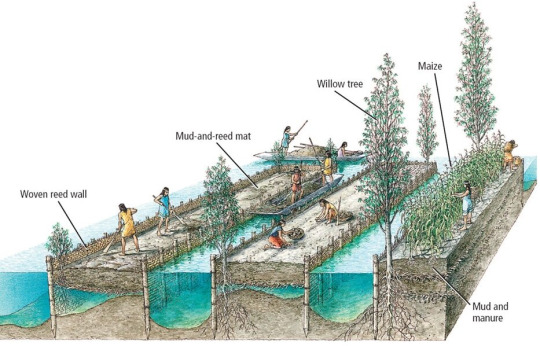
"Chinampa system is an historical system adapted to face hydrologic and climatic constraints and the pressure by the high city’s food demand. The chinampa farmers have been able to handle certain balance between the sustained yield and the environmental and technological management factors. This ecosystem performance has been based on the biological stability improvement, including sophisticated farming methods such as multiple cropping and shift of crops."
As you can see, they're man-made and developed by the Mexica (Aztecs) in the 14th century in the lakes of Xochimilco and Chalco, which surround Lake Texcoco, the lake that Mexico City takes residence in.

They're best described as “floating gardens” and due to the nutrient rich materials used to built them, are very fertile and can grow a great variety of crops. This of course includes Mexico's staple crop of maiz, but also beans, squash, tomatoes, chili peppers, and even flowers. The chinampas system provides a built-in natural irrigation system, and were home to aquatic wildlife and birds. This benefits the system further, as these animals increase the fertility and nutrients in the water and soil. There was also a drainage system, which facilitated the movement of water and sediments!
There were some cultural practices in association with chinampas, but they're best associated with the sort of 'urbanization' that Tenochtitlan was going under as the Mexica grew.
There have been much more recent studies done on the chinampas system, as modern agriculture as we know it is highly unsustainable due to lack of land and the general environmental concerns around agriculture. Utilizing chinampas in modern agricultural system has several benefits which include space efficiency, biodiversity, sustainable water management, carbon sesquention (migating climate change), and community engagement.
The last is particularly important, as it involves local communities in food production and builds on the concept of 'third-spaces' for people. Third spaces are typically places that individuals can spend time with their communities without the need to spend money for services or products. Libraries are the best example of this, but there have been others that have been lost over time.
This is not to say that chinampas don't exist anymore! They very much due primarily in San Gregorio, Xochimilco, Mexico City. THere are also some in San Luis, Tiahuac, and Mixiquic.
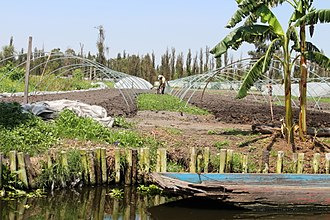
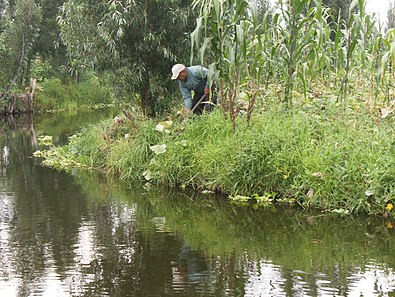
Other countries around the world have been inspired by chinampas, such as the Floating Gardens of Bangladesh, the Green Float project in Osaka Bay, Japan, and the Urban Rivers project in Chicago, USA.
There are some difficulties in maintaining current chinampas and bringing them back, as many of the original lakes were drained by the Spanish which reduced their ability to support agriculture. Earthquakes have also damaged them and the canals, as well as the scarcity of fresh water, pesticides, climate change, urban development, and water pollution.
I've gone on a bit long now, but I am familiar with the Inca and Quechua communication system you are referring to! It's a system based on knots if I'm not mistaken! I might be inclined to go into that in a future date!
#mochi asks#professor mochi#chinampas my beloved#nowadays theyre a popular tourist attraction#i think ryan and shane even went to a haunted one during buzzfeed unsolved
13 notes
·
View notes
Text
Support Families in Northern Gaza through Rooftop & Home Vegetable Gardens
"My name is Laila El-Haddad. I'm an author and advocate for Palestinian rights and food justice. Many of you might know me as the co-author of The Gaza Kitchen: A Palestinian Culinary Journey. I'm also an avid gardener and though I am from Gaza City, I'm a farmer at heart! Farmers represent the deep rootedness Palestinians have to the land. For Palestinians, farming, especially during a time of genocide and ecocide-is an act of deep faith and the very embodiment of Sumood- the Palestinian concept of steadfast perseverance.
Background
Once known for its lush apple orchards, strawberries, and citrus, northern Gaza is now completely cut off from the rest of Gaza.
As part of its policy to make Gaza unlivable, Israel has destroyed 50% of Gaza's trees and farmland, and severely restricted the entry of food and aid, especially to the north. The scale of damage and destruction is catastrophic. Israeli forces have leveled agricultural land, 90% of all greenhouses, olive groves, and poultry farms. The entire population is now facing a forced starvation policy and experiencing extreme hunger.
Your Donation Will Help Change This Reality by Providing Rooftop, Home, and Urban Vegetable Gardens through seedling and seed distribution for Vulnerable and Displaced Families in Northern Gaza who are subsisting on 245 calories a day.
What and Why?
I'm organizing this campaign to help support farmers and families in the areas of northern Gaza most impacted by Israel's ongoing war to start their own rooftop and home gardens-a small step towards self sufficiency and food sovereignty. All international and local aid agencies have had to evacuate from the north, leaving the population especially vulnerable, and whatever limited amounts of fresh produce and aid are available are sold astronomical prices.
How?
I spent months researching and consulting with agricultural experts in Gaza and abroad on the most secure and effective way to give Palestinians sustainable access to fresh produce. Next, I partnered with with the Gaza Palestinian American Association and the Middle East Children's Alliance, both accredited 501(c)(3) who are taking 0% overhead, as well as a team of community based partners in Gaza, who will be sourcing the supplies needed to start the home gardens locally and managing the project.
Our team on the ground has been working hard to source and start growing local seedlings to distribute to families, and other materials needed to provide them with the resources they desperately need to start their own home, rooftop, patio, and community vegetable gardens, depending on the spaces they have access to. We will roll out the project in several phases, which each phase targeting 100 families.
Each family will receive:
* At least 30 assorted seasonal vegetables seedlings (Palestinian summer squash, hot peppers, eggplant, cucumber and tomatoes, depending on availability)
* 80 grams of local seeds (dill, mulukhiya, chard),
* Compost, soil, and amendments
* Plastic planters, irrigation cans, where needed
* Training and follow up by agriculture experts
Your donations will also help fund the purchase of several solar panel systems to power community wells that communities rely on to drink and irrigate their gardens and farms with (currently, municipal access to water is limited to once every ten days, and well motors are inoperable due to an Israeli ban on the entry of fuel).
With your support, we can help Palestinian families sow the seeds of a brighter future, cultivate hope and grow some of their own food again!
Your donation is tax deductible and zakat eligible! 100% of the proceeds will go towards the project in Gaza!
Together, we will help families in the north grow healthy food for themselves, their neighbors and their friends!
5 notes
·
View notes